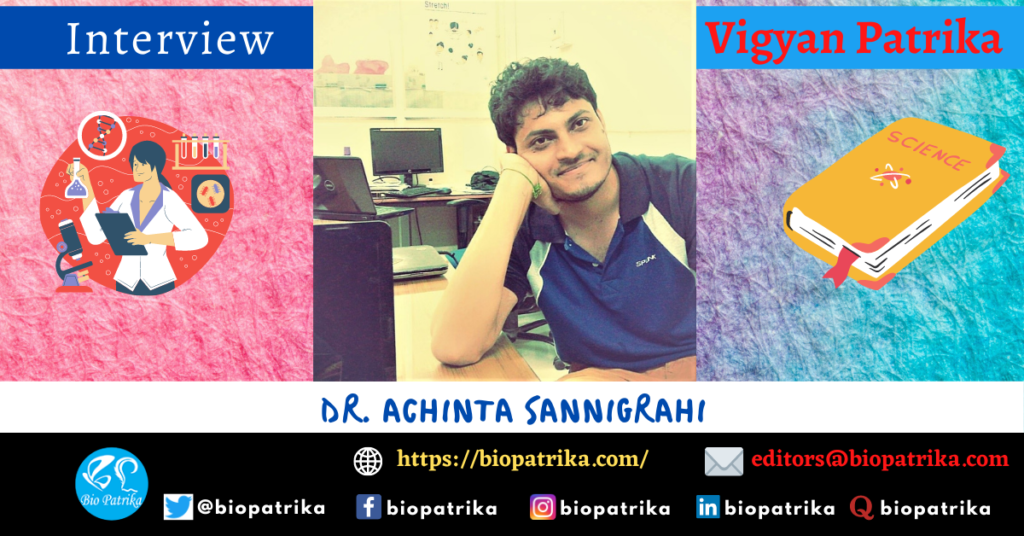Dr. Achinta Sannigrahi’s interview with Bio Patrika hosting “Vigyaan Patrika”, a series of author interviews. Dr. Sannigrahi is currently working as a postdoctoral research associate in the chemical engineering department of the Indian Institute of Science. He did his PhD in structural biology and bioinformatics division of CSIR-Indian Institute of Chemical biology under the supervision of Prof. Krishnananda Chattopadhyay (2014-2020). His PhD research work was based on protein-membrane interactions towards the understanding of molecular mechanisms of different pathogenic and neurodegenerative diseases. Achinta obtained his B.Sc. Degree in chemistry from Burdwan University (2009-2012). After that, he did his M.Sc. in the department of chemistry in IIT Guwahati (2012-2014). He qualified CSIR-UGC national eligibility test (Dec 2013) and GATE (2014) in chemical sciences. During his PhD work, Achinta received the prestigious Biophysical society travel award (2019) and an ICMR travel grant to attend the 63rd biophysical society meeting held in Baltimore, Maryland, USA. After PhD, Achinta received SERB-national postdoctoral fellowship for his postdoctoral work in IISC. Here, Achinta talks about a portion of his PhD work which is recently published in eLife (2021).
How would you explain your paper’s key results to the non-scientific community?
ALS, also known as Lou Gehrig’s disease after the name of a famous baseball player, is a fatal neurodegenerative disease, which causes nerve cell breakdown leading to progressive paralysis and ultimately death.Presently no cure is available for ALS. Although the aggregation of an enzyme Cu/Zn Superoxide dismutase (SOD1) is believed to be a potential causative factor behind ALS, lack of proper understanding about the disease pathophysiology makes it difficult for the development of a therapeutic solution. This enzyme SOD1 contains two metal cofactors, namely a Cu and a Zn. Here, we found out that, the process of aggregation of SOD1 might have a membrane connection. In addition, we figured out the regions of SOD1 which are responsible for the membrane induced aggregation and potentially the disease. We found out that these regions are residing near the Zn binding center of the enzyme. These locations are necessary for designing potential drug molecules against ALS.

the results would provide a mechanistic understanding of SOD1 aggregation and this process of aggregation can result in the disease pathology of ALS.
What are the possible consequences of these findings for your research area?
Our findings described in this publication may have two important implications. First, the results would provide a mechanistic understanding of SOD1 aggregation and this process of aggregation can result in the disease pathology of ALS. Second, this paper is expected to provide crucial insights, which might be helpful towards the development of a therapeutic solution against this complex disease.
What was the exciting moment (eureka moment) during your research?
It is known that ALS is a sporadic disease. However, SOD1 is known to have more than 140 ALS mutants. While different mutants are known to offer different extents of disease severity (period between onset and death), there was no known correlation between the physical/conformational traits of the mutants’ severity and the (word missing) severity. While we were developing this model, in which the membrane connections and the cofactor Zn were considered the key factors, we observed a correlation could be established between the disease severity and the distance between the mutation position and the Zn binding site. I do not think it was shown before and it was indeed the most exciting moment when we figured that out.
What do you hope to do next?
Our present work is mainly focused on in vitro studies. Our next step will be to test this in in-vitro model in animal and human patient systems, if possible.
Where do you seek scientific inspiration?
I was born and raised in a small place in West Bengal. However, education was always given priority in our upbringing and we were always told to ask questions. I have found that Indian scientists have contributed enormously to the process of scientific development while working under many constraints. I have always told myself that I can also help.
I have been inspired by my supervisor Prof. Krishnananda Chattopadhyay whose relentless participation and encouragement helped me a lot to do my research work in different projects. I have also been inspired by our group members, our collaborators and, the interesting research works, which are being carried out by various scientific folks worldwide.
How do you intend to help Indian science improve?
I am extremely proud of the way Indian science is progressing. However, I think that somehow the translation effort in Indian science is not able to catch up with the progress made by the basic biomedical Indian scientists.
I would continue to work hard to understand the molecular details of human biology using a multidisciplinary approach. After my post-doc in IISc, I would like to take up a faculty position in India and hopefully, the future research work from my group would produce few therapeutic molecules against diseases relevant to national interests.
Reference
Achinta Sannigrahi, Sourav Chowdhury, Bidisha Das, Amrita Banerjee, Animesh Halder, Amaresh Kumar, Mohammed Saleem, Athi N Naganathan, Sanat Karmakar and Krishnananda Chattopadhyay (2021) Metal cofactor zinc and interacting membranes modulate SOD1 conformation-aggregation landscape in an in vitro ALS Model, eLife 2021;10:e61453. DOI: 10.7554/eLife.61453
Dr. Krishnananda Chattopadhyay lab: https://iicb.res.in/faculty/krishnananda-chattopadhyay
Edited by: Ritvi Shah
